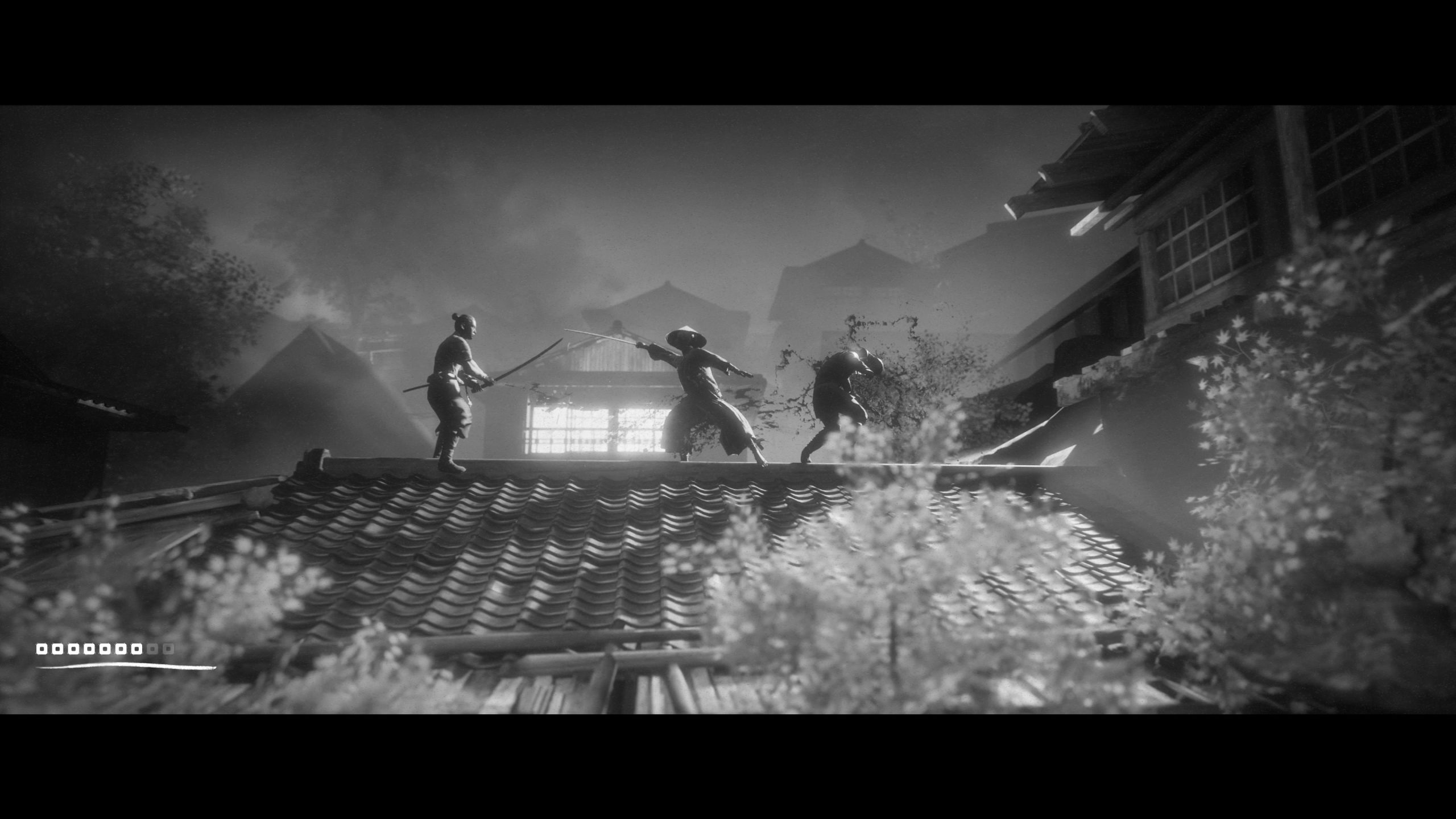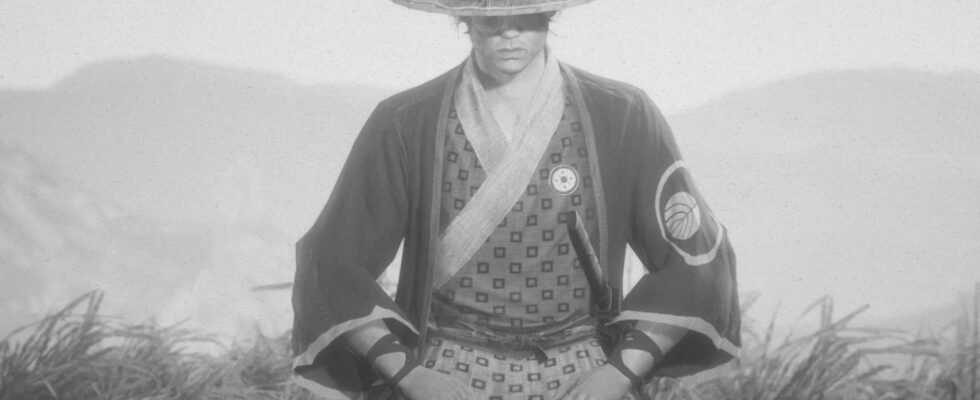After the sublime swan song of the PS4, the aptly named Ghost of Tsushima, another software will in turn venture into the terrain of feudal Japan: Trek to Yomi. An independent action-adventure title that caught our eye from the first trailer for its devastating aesthetics. But what is it really worth beyond the artistic demonstration? We sharpened our finest katana to find out.
Trek to Yomi opens with a flashback in which young Hiroki, the character we play, trains with his sensei to later become a skilled samurai. But now, this lesson aimed at teaching us the basics and the particular philosophy of katana combat quickly takes a tragic turn, when bandits besiege the village and their leader, Kagerô, takes the life of our shidoshi. Before dying, the latter makes us promise one thing: to protect the inhabitants and his daughter Aiko from potential future threats. Several years after this violent attack, history repeats itself, which will allow us to honor our word and wreak our vengeance in the name of our master. We can guess pretty quickly, the script for Trek to Yomi will never deviate from its objective of telling us a story of vendetta, in the purest tradition of samurai films, and that’s good because it gets to the point. Maybe even too much. We never really have time to really get attached to the characters and the summary animations, independent production obliges, do not help.
However, the game also revolves around a second very interesting element: Shintoism. It is a religion based on respect for the Kami, the deities, like the sun goddess Amaterasu. An evocative name if you’ve played (or at least heard of) Okami. Unfortunately, we regret that this subject is mainly approached through objects to collect in the environments, even if once again, the budgetary constraint may have limited the possibilities at this level. In any case, Leonard Menchiari, the director of Trek to Yomi, puts his heart into the work to bring a minimum of lore and go beyond the classicism of the frame.
A playable film by Akira Kurosawa
As said in the preamble, the title of Leonard Menchiari and Flying Wild Hog (Shadow Warrior 3) immediately flattered our retina. And our first good impressions lasted throughout. Unlike Ghost of Tsushima which offered an optional “Kurosawa filter”, Trek to Yomi requires it. He adopts this ultra polished black & white aesthetic and claims it at all times, in order to pay a vibrant tribute to Japanese films of the 50s and 60s such as those of Akira Kurosawa precisely. The result is simply dazzling visuals for a software of this magnitude. The grain of the image, the defects of film, everything is meticulously transcribed there to make us live an authentic journey in the heart of feudal Japan. And that’s without counting on the impeccable staging where each shot is scrupulously studied. We are facing a 2.5D game that uses fixed cameras. An ingenious artistic choice that allows Leonard Menchiari to show us what he wants. Whether it’s a close-up of a sword before a confrontation, a play of shadows behind Japanese panels, or the sight of bodies hanging from the entrance to a burning village with the moonlight in the background, the developer captures every opportunity he can to deliver ultra stylized scenes. Impossible not to be seduced by the proposal which is undoubtedly a nice slap. The environments are varied (fields, caves, cemeteries, dwellings…) and very successful.

A professional short filmmaker, Leonard Menchiari also wanted the soundscape to match the visuals. And he and his teams didn’t do things by halves by hiring the services of Japanese dubbers who lent their voices to works like Street Fighter 5, Resident Evil Village, Hunter X Hunter… or even Metal Gear Solid. Akio Ōtsuka, famous seiyū known for his roles as Solid Snake and Big Boss in Hideo Kojima’s saga, is indeed in the game. Too bad his interventions are so rare in the adventure. On the dubbing side, it is therefore extremely convincing and fortunately, because the immersion would clearly not have been the same with a VF. The overall sounds also lend this authenticity to the title. The cries of frightened villagers, the simple sound of leaves etc.
Trek to Yomi: Hard fights
An idyllic picture? We might think so and we wanted to believe it, but it is clear that the game mechanics do not follow. Simple but not simplistic, the gameplay of Trek to Yomi had everything to please. By observing little friends like Ghost of Tsushima or Sekiro, the title could have provided us with a satisfactory synthesis of its models. But ultimately, the execution of the fights is too wobbly with vagueness, an unsettling floating sensation, latency and a cruel lack of impact when the blades collide. Hiroki has a life bar which limits the damage he can take, and a stamina bar which restricts all his actions. Weak or strong blows, rolling, parrying or blocking, all movements influence his state of fatigue. And when the stamina bar is depleted, we are at the mercy of enemies who kill us with just a few attacks.
Because of the strangeness of the parade for example, it will not be uncommon to eat shots for free. This is all the more true since at times, Leonard Menchiari favors his artistic direction too much to the detriment of the fights. In the second part of the game, which is more fantastic, it is not uncommon to see the camera go far too far from the action, which therefore makes the confrontations more laborious than they should be and prevents us understand when to parry an assault. It’s downright frustrating when that happens. But in normal difficulty, the game is not stingy with checkpoints, symbolized by small prayer shrines. These points of interest allow you to recover health and save progress. Because in Trek to Yomi, you can only recover life in two ways: you must necessarily interact with a shrine or perform a final blow (eg by cutting off an opponent’s head). Since we move on a horizontal plane, our hero also has a special key to turn around. Again, this could cause some problems.
Hiroki Sakai

In addition to defensive skills (parry, volte-face…), we have offensive skills that encompass all combos (usually a combination with one direction and three four buttons, with for example: forward + square, square, square), each being more or less effective depending on the enemy. Those who like contact are, for example, sensitive to pierced attacks. But it’s not always easy to identify the right combination that will hit the mark every time. In summary, if you expect rewarding brawls like Ghost of Tsushima or Sekiro: Shadows Die Twice, Trek to Yomi isn’t for you. Hiroki also has other abilities such as ranged weapons (bow, rifle or shurikens) to clean up and avoid getting overwhelmed. All of these tools are unlocked naturally as you progress through the story and explore the settings. A word also on the bosses who are not terrible. Normally, they can fall off easily, and more importantly, the lack of real patterns and phases makes it all rather boring. This is also the main problem of the game. Because of its gameplay weaknesses, Trek to Yomi can be boring if you are totally hermetic to the artistic proposal. Some will be able to ignore it, but it must be understood that this will not be the case for everyone. In short, we are more in front of a chrysalis than a butterfly.
